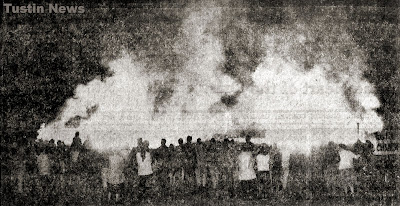 |
| View from Modjeska Peak, July 2009 (Photo by author) |
Q: Why do you call the prominent double-peak in the Santa Ana Mountains "Old Saddleback" and not just "Saddleback?"
A: According to the late great historian Phil Brigandi, we call it “Old Saddleback” because that’s been its name since the 1860s.
The distinctive silhouette of Old Saddleback is made up of Santiago Peak and Modjeska Peak, the highest summits in Santa Ana Mountains. In the last half-century, it's been popular to apply an abbreviated "Saddleback" moniker to schools, businesses, churches and even the Saddleback Valley. But the mountains don't change. They even appear on our county's logo.
Historian Don Meadows wrote, "No paisano would ever think of shortening the name. It is always OLD Saddleback to those who love the country."
Dropping "Old" from the name is like saying "Frisco" instead of San Francisco: Locals will inspect you for bruises left by your fall from the turnip truck.
Q: Is there any gold to be mined here in Orange County?
A: There's gold in them thar Santa Ana Mountains! But probably not enough to make searching for it worthwhile.
Perhaps the most notable of the many prospectors who learned this the hard way was Fullerton's Jacob "Jake" Yaeger. In 1886, while hunting game in Trabuco Canyon, he stumbled across an outcropping of gold ore.
By 1922 he had spent $125,000, and the best years of his life, digging over 5,000 feet of mine tunnels, (and an additional 1,900 feet just to drain water out of the mine). He worked by candlelight, with rattlesnakes, bears, and mountain lions as his neighbors. Jake remained optimistic right up to his death in 1928, but he never found enough gold to pay for even a fraction of his efforts.
Currently, there’s another fellow who claims he’s found a bit of gold ore in Lucas Canyon and has staked a claim. But if history and geology are any indicators, it’s probably best not to hold your breath waiting for a second California Gold Rush.
Q: "Carbondale” is listed as one of Orange County’s California Historical Landmarks. What is it?
A: Located near the mouth of Silverado Canyon, the town of Carbondale simply disappeared. Ramon Mesquida found coal here in 1878 and told a few miners who were still lingering in Silverado after the silver boom. They formed the Santa Clara Coal Mining Co. and their biggest customer was the Southern Pacific Railroad. Coincidentally, it turned out the railroad already owned the land the miners claimed.
The Railroad took over in 1881, and a boom town quickly sprang up. Modestly named Harrisburg by mine superintendent Tom Harris, it had a store, saloon, hotel, school, and miners’ shacks. But there was already a Harrisburg, California, and so it was renamed Carbondale. Like Silverado, Carbondale’s boom went bust and the town was nearly empty by 1883. Carbondale died when the saloon closed, but spasmodic attempts at mining continued until 1917.
Today, the only signs of Carbondale are historical plaques outside Calvary Chapel of the Canyons. [Update: Mountain maven Mike Boeck posts that the Bond Fire of Dec. 2020 burned away enough brush to expose a remaining small portion of one of Carbondale's buildings. He says the mine itself still exists "on the north side of the road,"but that the approach is too clogged with brush for even an experienced bushwhacker like himself to access it.]





